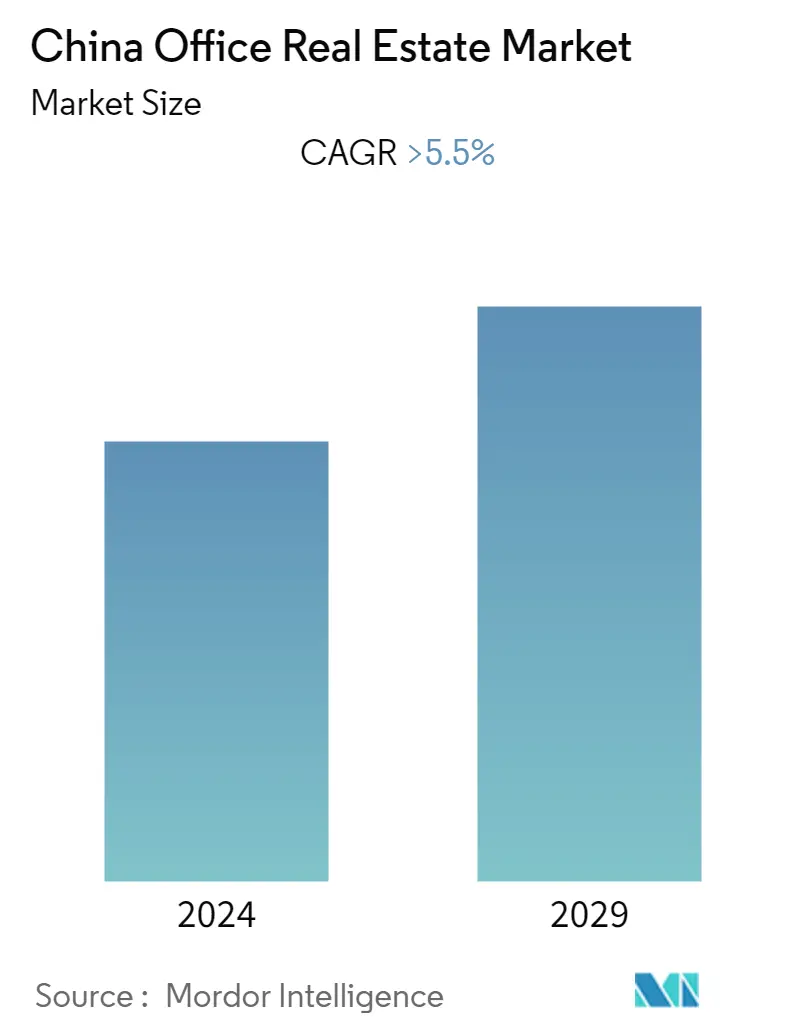Market Size of China Office Real Estate Industry

| Study Period | 2019 - 2029 |
| Base Year For Estimation | 2023 |
| Forecast Data Period | 2024 - 2029 |
| Historical Data Period | 2019 - 2022 |
| CAGR | > 5.50 % |
| Market Concentration | Low |
Major Players
*Disclaimer: Major Players sorted in no particular order |
China Office Real Estate Market Analysis
During the period from 2023 to 2028, the China office real estate market is expected to register a CAGR of more than 5.5%.
- Due to restrictions, social distancing policies, and a work-from-home culture, COVID-19 had a significant impact on China's office real estate market. The COVID-19 pandemic in China resulted in significant changes in workplace working habits and locations. As a result of the pandemic, the majority of businesses implemented remote working.
- The volume of commercial real estate investments on the Chinese mainland reached USD 7.3 billion in the third quarter of 2021, and the full-year amount is expected to surpass that of 2020. Office investments took the lion's share, or 57.6 percent, of the volume of commercial real estate investments in the third quarter, up 14.2 percent quarter-on-quarter. In 2021, eight of the world's top 20 most expensive office spaces will be in China. These include Beijing Financial Street, Beijing's Central Business District, and Shanghai's Pudong New Area.
- With the recovery of Beijing's commercial real estate investment market continuing through year-end, the 2021 total sales volume exceeded 60 billion yuan (USD 8.92 billion), with nearly 60 transactions recorded. The figure was the second highest in the previous five years, up 35% from 2020. Office properties remained hot in 2021, accounting for 56 percent of the total transaction volume. In the first half of 2021, SK Tower sold for CNY 9.06 billion (USD 1.35 billion), making it the highest-priced single-asset deal to close since 2019. The total transaction volume for retail properties rose 34 percent year-on-year, with Brookfield's acquisition of Yuehui Vanke Plaza drawing great interest in the market.
China Office Real Estate Industry Segmentation
Office real estate is the construction of buildings for leasing and selling purposes to companies from different sectors. This report aims to provide a detailed analysis of the Chinese office real estate market. It focuses on the office real estate sector's market insights, dynamics, technological trends, and government initiatives.
China's office real estate market is segmented by sector (Information Technology (IT and ITES), Manufacturing, BFSI (Banking, Financial Services, and Insurance), Consulting, and Other Services) and by major cities (Beijing, Shanghai, Guangzhou, Shenzhen, Chengdu, and the Rest of China). The report offers market size and forecasts in values (USD)for all the above segments.
| By Major Cities | |
| Beijing | |
| Shanghai | |
| Rest of China |
| By Sector | |
| Information Technology (IT and ITES) | |
| Manufacturing | |
| BFSI (Banking, Financial Services, and Insurance) | |
| Consulting | |
| Other Services |
China Office Real Estate Market Size Summary
The Chinese office real estate market is poised for significant growth, driven by a recovery from the disruptions caused by the COVID-19 pandemic. The pandemic led to a shift in workplace dynamics, with many businesses adopting remote work policies, which initially impacted the demand for office spaces. However, as the market recovers, there has been a notable increase in commercial real estate investments, particularly in office properties, which have become a substantial portion of the investment volume. Major cities like Beijing and Shanghai continue to host some of the world's most expensive office spaces, attracting both domestic and international investors. The demand for office spaces is further bolstered by the presence of large tech and finance companies, which have contributed significantly to the market's expansion.
The rise of co-working spaces is a notable trend in the Chinese office real estate sector, driven by the need for flexible and cost-effective office solutions, especially among freelancers, entrepreneurs, and small to medium-sized enterprises (SMEs). Cities like Beijing, Guangzhou, and Wuhan are leading in the proliferation of co-working spaces, offering amenities that cater to modern business needs. Despite the challenges posed by high rental costs, the market remains competitive, with both domestic and foreign players vying for a share. The introduction of initiatives like the private equity real estate pilot program aims to attract more foreign investment and enhance market liquidity. This competitive landscape is further supported by key developers and the increasing interest from global institutional investors, making China a preferred destination for office real estate investment.
China Office Real Estate Market Size - Table of Contents
-
1. Market Insights
-
1.1 Market Overview
-
1.2 Technological Trends in the Industry
-
1.3 Government Initiatives and Regulatory Aspects
-
1.4 Industry Value Chain Analysis
-
1.5 Insights on Rental Yields in the Office Real Estate Segment
-
1.6 Insights on the Key Office Real Estate Industry Metrics (Supply, Rentals, Prices, Occupancy (%) / Vacancy (%))
-
1.7 Insights on Office Real Estate Construction Costs
-
1.8 Impact of COVID-19 on the Market
-
-
2. Market Segmentation
-
2.1 By Major Cities
-
2.1.1 Beijing
-
2.1.2 Shanghai
-
2.1.3 Rest of China
-
-
2.2 By Sector
-
2.2.1 Information Technology (IT and ITES)
-
2.2.2 Manufacturing
-
2.2.3 BFSI (Banking, Financial Services, and Insurance)
-
2.2.4 Consulting
-
2.2.5 Other Services
-
-
China Office Real Estate Market Size FAQs
What is the current China Office Real Estate Market size?
The China Office Real Estate Market is projected to register a CAGR of greater than 5.5% during the forecast period (2024-2029)
Who are the key players in China Office Real Estate Market?
Wanda Group, Country Garden Holdings, China Vanke Co., Sunac China Holdings and Poly Real Estate are the major companies operating in the China Office Real Estate Market.

